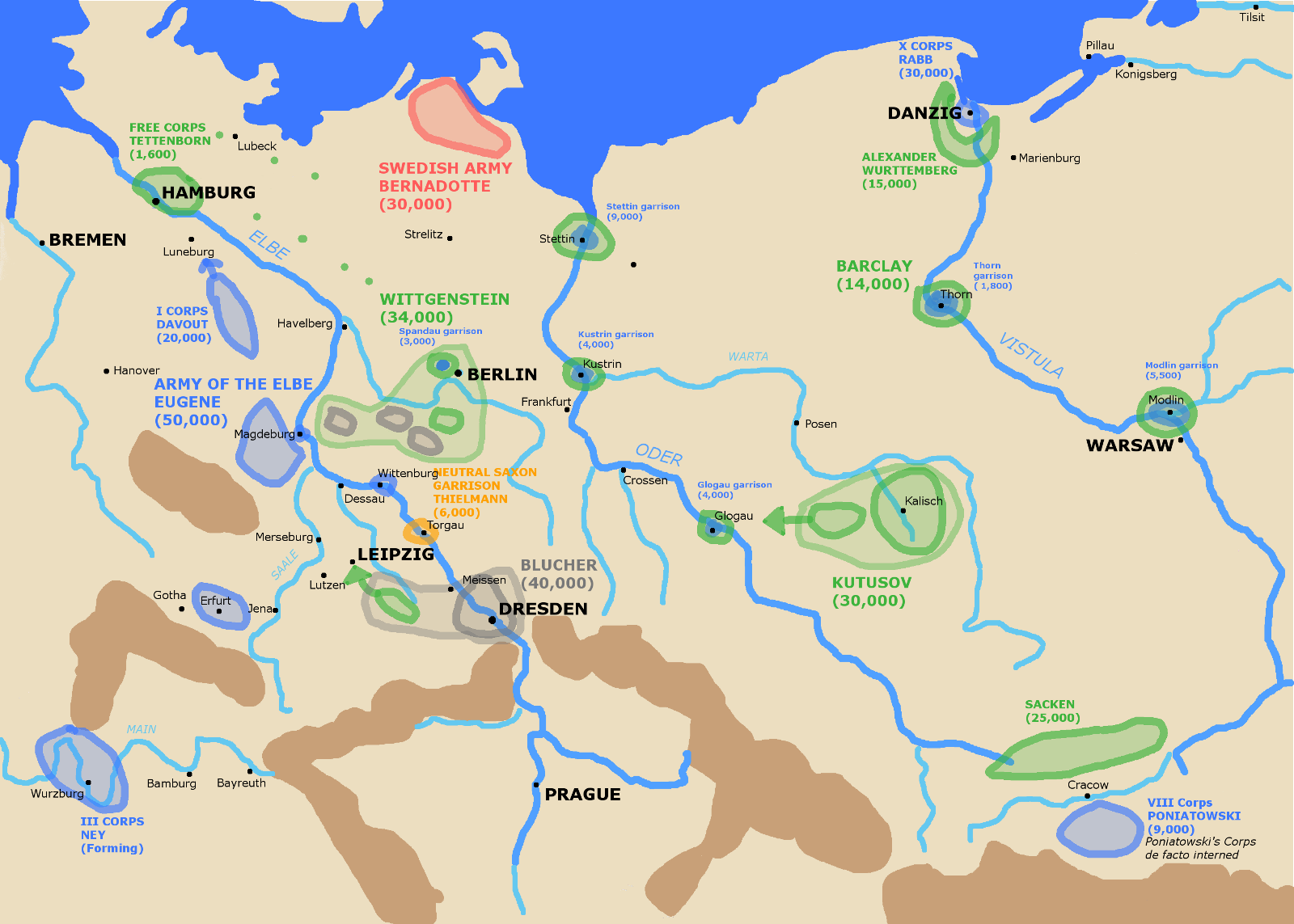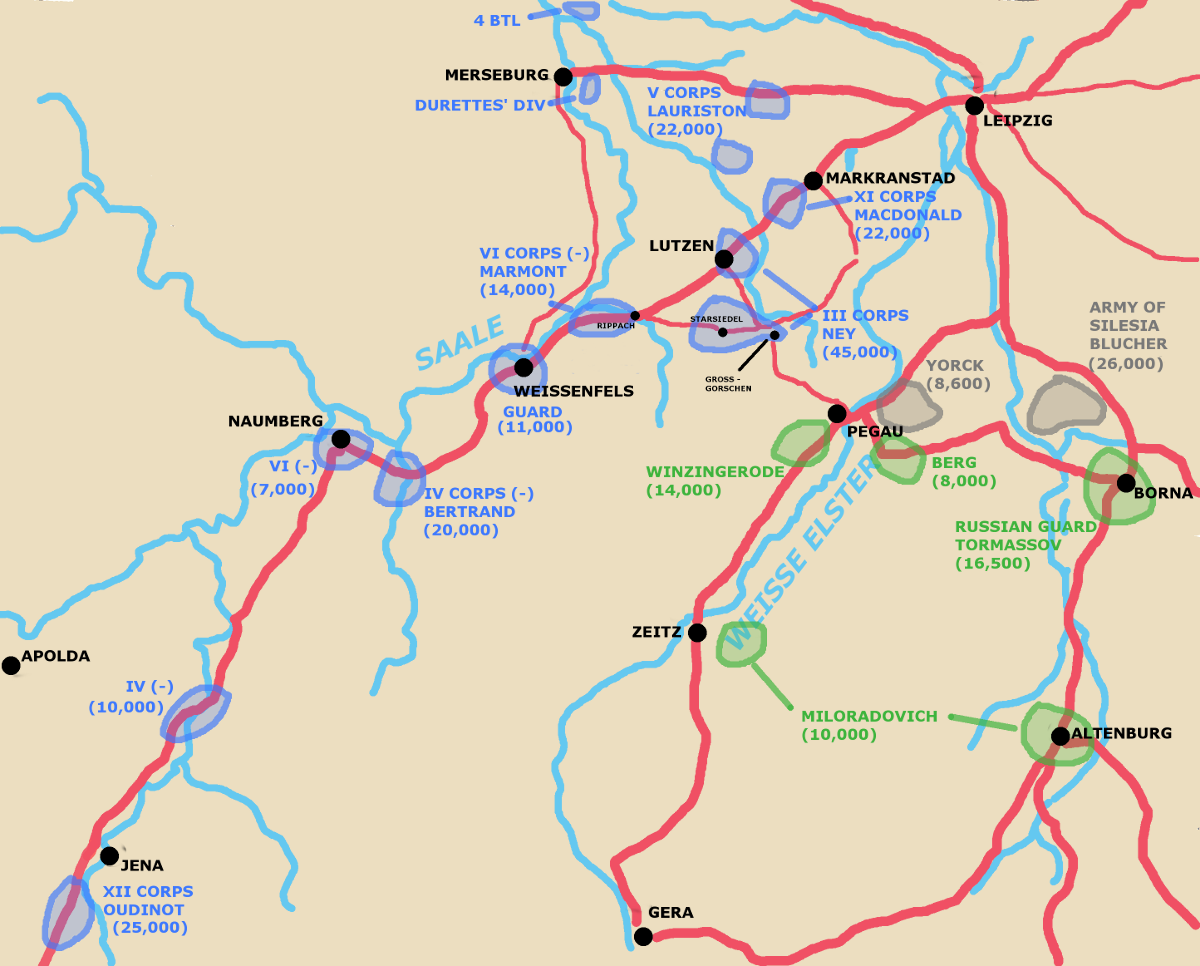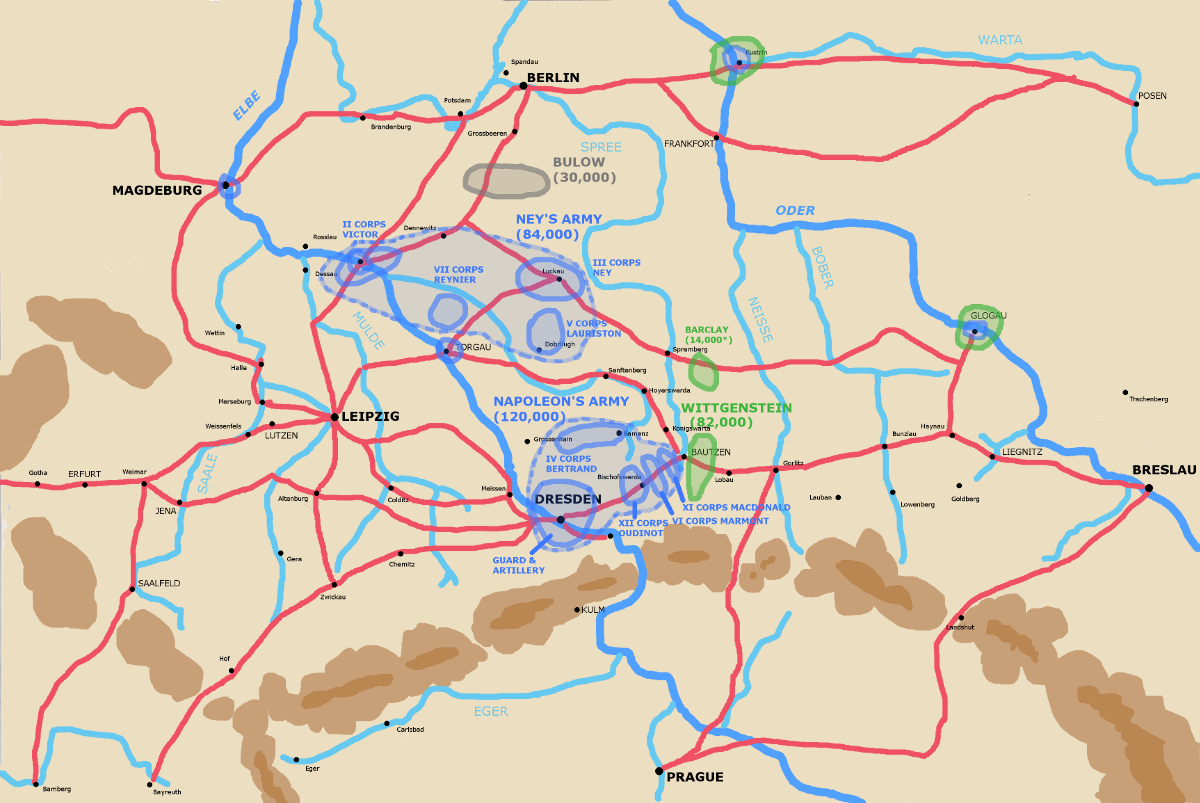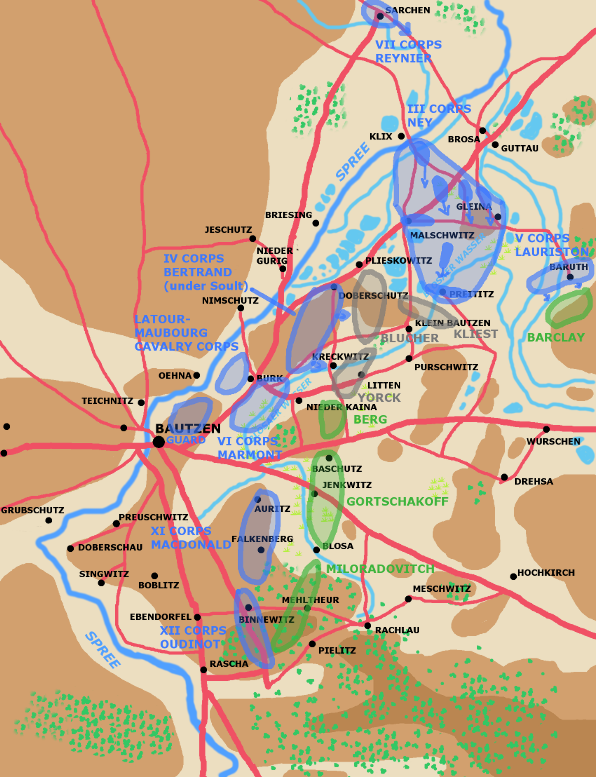Lutzen at mid-day

Lutzen in evening

The Grande Armee's remnants stagger back from Russia. They're not adequate to stop the pursuing Russians even though the Russian forces themselves are diminished and exahusted. The Prussian and Austrian corps on the Grande Armee flanks which remained sufficiently intact to do so didn't. They had de facto deserted the French cause.
The situation was very confused and uncertain and remained so for months. The French maintained large garrisons as far east as Danzig and Modlin near Warsaw, but Cossack raiding forces reached as far west as Hamburg.
A timeline of indicative events goes as follows:
N.B. Transliteration of Russian names can be variable, in particular note "ch" can also be "tsch", and "uv" can be "ow".
Wittgenstein commanded the Russian Force that began on northern flank, Chichagov (Tschitschagov) the Russian force that began on the southern flank, Kutusov commanded the main Russian force. Miloradovich commanded Kutusov's Advance Guard, and Tettenborn a large force of Cossacks. Murat, Davout, Grenier, and Eugene were major French leaders. Yorck commanded the Prussian Corps formerly detached to Grande Armee.
French remnants still staggering. They're effectively in the last stages of their retreat from Russia. The Allied Russians and Prussians are not in great shape themselves however.
A Map showing the strategic situation in Northern Germany and Poland at the end of March 1813

MAP KEY: French - Blue, Russians - Green, Prussians - Grey, Swedes - Light Red, Neutral Saxons - Orange
Both command structures and force levels were in chaotic flux throughout the spring. Numbers are attempts at the number of effectives. In north west Germany a number of Free Corps and locally recruited miltias were operating. It took until May for Davout to suppress them. Wittgenstein had a number of Prussian Corps (effectively large divisions) under command, two Bulow and Borstell are shown on the map as one blob just to the east of Magdeburg, Yorck's Advance Guard under Kliest is shown seperately to the south of Yorck's blob, the rear green blob represents the Russian corps of Berg. Wittgenstein also had troops technically under his command detached to the seiges of Spandau and Danzig.
Blucher had 14,000 Russians under Winzingerode serving as his advance guard they're shown on the map as advancing on Leipzig.
Kutusov's advance guard under Miloradovitch was following in Blucher's footsteps, but the main Russian force did not start to leave Kalisch until April 7th.
Napoleon was building his new Army of the Main, both on the upper Main and around Erfurt. These troops were still forming and in a wide state of readiness.
The Saxons at Torgau were not permitting either side to use the bridge across the Elbe there.
It might not be obvious on the map but the French had garrisons in both Magdeburg and Wittenburg controlling the strategically important crossings there.
Eugene had about 50,000 men under direct command.
A very dangerous situation in North West Germany especially occupation of Hamburg by a free corps under Tettenborn and its subsequent defection resulted in Napoleon ordering I Corps under Davout to be detached to handle it. Also a cavalry corps under Sebastiani was sent to watch the lower Elbe.
New formations destined to be Army of the Main being created and trained at Erfurt and on upper Main (Wurzburg etc)
The allies had multiple forces of various qualities beseiging french forts and conducting raids, below are just the field armies free to operate against the french field army. Barclay's force was beseiging Thorn but represented the veteran southern Russian army and Thorn being under garrisoned was due to fall in mid-May freeing him up. Wittgenstein's force and Blucher's were the main Allied strike forces, they were backed up by Kutusov's main Russian army although Kutusov was seeking to rest and reconstitute his depleted formations at Kalisch. Kutusov died on April 28th and overall command of the Allied forces went first to Wittgenstein and then after Bautzen to Barclay. There was considerable political interference in the military command on the Allied side especially from the Russian Emperor Alexander.
Wittgenstein
Barclay de Tolly, (remnants Russian southern army) 14,000 men besieging Thorn
Kutusov (Russian main force) 30,000 men
Blucher
Map showing situation in Northern Gemany April 25th 1813

Army of the Main under Napoleon with 140,000 men
Army of the Elbe under Eugene with 62,000 men
In total both french armies had 202,000 men.
Wittgenstein
Blucher
Russian Main Army under Kutuzov (ill died 28th)
In total the Allies had about 90,000 men in their field armies.
Map showing operational situation around Lutzen on May 1st 1813.

Having joined his newly formed Army of the Main in late April Napoleon moves on Leipzig in a long drawn out straggle of Corps. The Allies see an opportunity to strike at the flank of this march and catch one of the French Corps alone and at a disadvantage. The attack was supposed to go in early on May the 2nd against a set of Ney's divisions dispersed south of Lutzen. In the event the Allied execution was flawed. It was almost noon before Blucher's Prussians attacked. As a result of poor reconnaissance they faced a much stronger enemy than they'd expected.
More details can be found on the battles page in the entry for Lutzen. However, in brief, the Allies had underestimated how fast Napoleon could rally his dispersed forces on the battlefield. Only the arrival of night saved them from a double envelopement, by Bertrand's Corps on their left and MacDonald's Corps on their right.
Maps showing progress of Battle of Lutzen on May 2nd 1813 from mid-day to evening.
| Lutzen at mid-day  |
Lutzen in evening  |
Despite it being a technical french victory, something Napoleon milked for all the propaganda value possible, Napoleon failed to annihilate the Allied forces at Lutzen. They withdrew in good order. Their rearguard under Miloradovich staged a series of hard fought, expertly executed rearguard actions that kept Napoleon at bay. The main allied force crossed the Elbe at and below Dresden eventually concentrating behind the Spree around Bautzen just about the middle of May. Barclay de Tolly having finished the seige of Thorn joined them there on May 16th.
A northern allied force under Bulow withdrew towards Berlin gathering fresh newly recruited units as it did so. Napoleon dispatched Ney with his own III Corps and what had been Eugene's Army of the Elbe via Torgau on the Elbe to follow up on this movement. Torgau was held by neutral Saxons under Theilmann and Ney was prepared to bridge the Elbe. It proved unecessary as Napoleon was able to browbeat the King of Saxony into becoming his ally. Theilmann defected to the allies, but the Saxon army and Torgau became French.
Ney moved to concentrate around Luckau. The intent was he could pose a threat to either Berlin or the flank of the Allied main force there.
Map showing situation in Northern Germany on May 15th 1813.

Ney's Army with 84,300 men
Napoleon's Army with 119,000 men
In total the effective strength of the two french field armies was about 203,300.
Wittgenstein would have about 96,000 men for the battle of Bautzen. His Prussian subordinates were Blucher, Yorck and Kliest. Russian subordinates were Barclay, Miloradovitch, Berg, Gortschakoff and Constantine.
The allies decided to stand behind the Spree at Bautzen. It took the cavalry deprived french a while to discover this.
But by May 15th Napoleon with his main army was closing up to their position. Three of Napoleon's four corps were on the Dresden to Bautzen road, Macdonald's XI Corps in the lead, followed by Marmont's VI Corps, with Oudinot's XII Corps taking up the rear. The Guard was mostly around or in Dresden. Bertrand's IV Corps was off north on protecting the Army's left flank.
A detailed account can be found on the battles page in the Bautzen entry. In brief, however, Napoleon's plan was to hold the allies in place with his main army while Ney's army flanked them from the north. It is unclear and rather controversial whether Napoleon wanted Ney to split his army and both attack Berlin and make the flanking action with only part of the northern French army. Or to concentrate his forces on the flanking attack. Apparently Ney splitting his forces was Napoleon's original plan, that Ney misunderstood, but then Napoleon changed his mind and decided a concentrated flank attack was better.
What is clear is that confusion and poor staff work reigned with the result that Ney didn't effectively threaten Berlin and did not arrive concentrated on the Allies northern flank on May 21st as planned.
The 20th saw Oudinot cross the Spree above Bautzen at Singwitz and drive into the Allied left (southern) flank. MacDonald and Mormont later attacked through and north of Bautzen establishing more central bridgeheads across the Spree. It should be noted, however spirited the Allied resistance in Bautzen and on the Spree under Miloradovitch was, that their main field fortified defenses lay further back mostly behind the Blosaer Wasser. The French attacks did result in Alexander overruling Wittgenstein and dispatching the allied reserves to their left flank.
On the 21st Ney came down from the north with his and Lauriston's Corps and just failed to close the jaws of Napoleon's trap. Soult with Bertrand's Corps and Napoleon with Marmont's Corps and the Guard kept the Allies busy to their front.
Map showing battle at Bautzen 20th and 21st of May 1813.
|
Early on May 20th 1813. 
|
At noon on May 21st 1813. 
|
Note: the first map exaggerates how close Ney's army was. In particular Victor's and Reynier's Corps lagged far behind. Ney promised he could be on the Spree "in force" on the 21st. Klix was his designated crossing point.
Bautzen like Lutzen was a technical French victory that fell short of being the desired battle of annihilation. The Allied retreat was mainly through Gorlitz on the Neisse. Once again lacking cavalry and the hard marching veterans of previous years, and facing a cohesive Allied force that fought determined rear guard actions, the French pursuit was ineffective.
Map showing operational situation in Eastern Germany at time of Armistice June 1st 1813.

On the map by traditional measures the Allies were facing total defeat. Their poor military situation, out numbered and pushed up against the Austrian border cut off from their lines of communication, was exacerbated by a serious divide between the Prussians and Russians as to what to do next. Contemporaries report Napoleon's offer of an armistice was met with joyous laughter at the Allied HQ. Napoleon himself counted this his biggest mistake. At the time, however, his lines of communication were under severe threat, the actual of attitude of Austria was very uncertain, his army was falling apart, and his lack of effective cavalry was keeping any of his expensively won victories from being decisive.
While researching for this post came across two books by Michael V. Leggiere that look very useful but which I haven't yet found the time to actually read. They are: